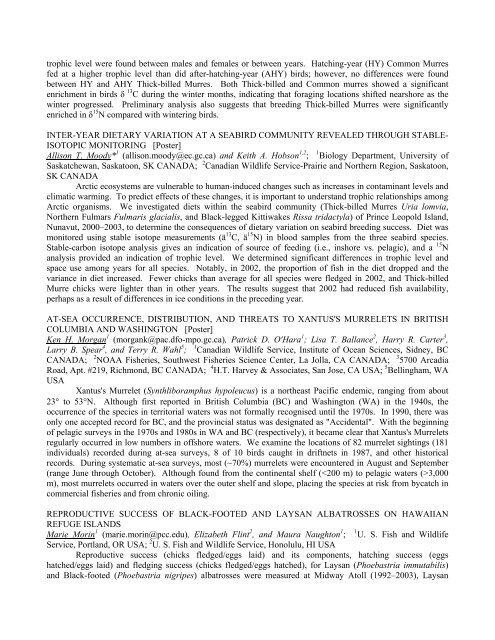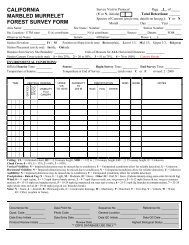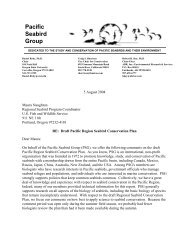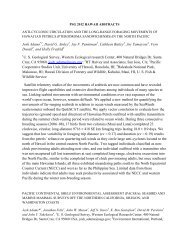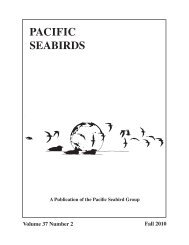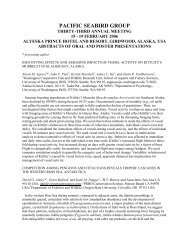abstracts of oral and poster presentations - Pacific Seabird Group
abstracts of oral and poster presentations - Pacific Seabird Group
abstracts of oral and poster presentations - Pacific Seabird Group
You also want an ePaper? Increase the reach of your titles
YUMPU automatically turns print PDFs into web optimized ePapers that Google loves.
trophic level were found between males <strong>and</strong> females or between years. Hatching-year (HY) Common Murres<br />
fed at a higher trophic level than did after-hatching-year (AHY) birds; however, no differences were found<br />
between HY <strong>and</strong> AHY Thick-billed Murres. Both Thick-billed <strong>and</strong> Common murres showed a significant<br />
enrichment in birds δ 13 C during the winter months, indicating that foraging locations shifted nearshore as the<br />
winter progressed. Preliminary analysis also suggests that breeding Thick-billed Murres were significantly<br />
enriched in δ 15 N compared with wintering birds.<br />
INTER-YEAR DIETARY VARIATION AT A SEABIRD COMMUNITY REVEALED THROUGH STABLE-<br />
ISOTOPIC MONITORING [Poster]<br />
Allison T. Moody* 1 (allison.moody@ec.gc.ca) <strong>and</strong> Keith A. Hobson 1,2 ; 1 Biology Department, University <strong>of</strong><br />
Saskatchewan, Saskatoon, SK CANADA; 2 Canadian Wildlife Service-Prairie <strong>and</strong> Northern Region, Saskatoon,<br />
SK CANADA<br />
Arctic ecosystems are vulnerable to human-induced changes such as increases in contaminant levels <strong>and</strong><br />
climatic warming. To predict effects <strong>of</strong> these changes, it is important to underst<strong>and</strong> trophic relationships among<br />
Arctic organisms. We investigated diets within the seabird community (Thick-billed Murres Uria lomvia,<br />
Northern Fulmars Fulmaris glacialis, <strong>and</strong> Black-legged Kittiwakes Rissa tridactyla) <strong>of</strong> Prince Leopold Isl<strong>and</strong>,<br />
Nunavut, 2000–2003, to determine the consequences <strong>of</strong> dietary variation on seabird breeding success. Diet was<br />
monitored using stable isotope measurements (ä 13 C, ä 15 N) in blood samples from the three seabird species.<br />
Stable-carbon isotope analysis gives an indication <strong>of</strong> source <strong>of</strong> feeding (i.e., inshore vs. pelagic), <strong>and</strong> a 15 N<br />
analysis provided an indication <strong>of</strong> trophic level. We determined significant differences in trophic level <strong>and</strong><br />
space use among years for all species. Notably, in 2002, the proportion <strong>of</strong> fish in the diet dropped <strong>and</strong> the<br />
variance in diet increased. Fewer chicks than average for all species were fledged in 2002, <strong>and</strong> Thick-billed<br />
Murre chicks were lighter than in other years. The results suggest that 2002 had reduced fish availability,<br />
perhaps as a result <strong>of</strong> differences in ice conditions in the preceding year.<br />
AT-SEA OCCURRENCE, DISTRIBUTION, AND THREATS TO XANTUS'S MURRELETS IN BRITISH<br />
COLUMBIA AND WASHINGTON [Poster]<br />
Ken H. Morgan 1 (morgank@pac.dfo-mpo.gc.ca), Patrick D. O'Hara 1 ; Lisa T. Ballance 2 , Harry R. Carter 3 ,<br />
Larry B. Spear 4 , <strong>and</strong> Terry R. Wahl 5 ; 1 Canadian Wildlife Service, Institute <strong>of</strong> Ocean Sciences, Sidney, BC<br />
CANADA; 2 NOAA Fisheries, Southwest Fisheries Science Center, La Jolla, CA CANADA; 3 5700 Arcadia<br />
Road, Apt. #219, Richmond, BC CANADA; 4 H.T. Harvey & Associates, San Jose, CA USA; 5 Bellingham, WA<br />
USA<br />
Xantus's Murrelet (Synthliboramphus hypoleucus) is a northeast <strong>Pacific</strong> endemic, ranging from about<br />
23° to 53°N. Although first reported in British Columbia (BC) <strong>and</strong> Washington (WA) in the 1940s, the<br />
occurrence <strong>of</strong> the species in territorial waters was not formally recognised until the 1970s. In 1990, there was<br />
only one accepted record for BC, <strong>and</strong> the provincial status was designated as "Accidental". With the beginning<br />
<strong>of</strong> pelagic surveys in the 1970s <strong>and</strong> 1980s in WA <strong>and</strong> BC (respectively), it became clear that Xantus's Murrelets<br />
regularly occurred in low numbers in <strong>of</strong>fshore waters. We examine the locations <strong>of</strong> 82 murrelet sightings (181<br />
individuals) recorded during at-sea surveys, 8 <strong>of</strong> 10 birds caught in driftnets in 1987, <strong>and</strong> other historical<br />
records. During systematic at-sea surveys, most (~70%) murrelets were encountered in August <strong>and</strong> September<br />
(range June through October). Although found from the continental shelf (3,000<br />
m), most murrelets occurred in waters over the outer shelf <strong>and</strong> slope, placing the species at risk from bycatch in<br />
commercial fisheries <strong>and</strong> from chronic oiling.<br />
REPRODUCTIVE SUCCESS OF BLACK-FOOTED AND LAYSAN ALBATROSSES ON HAWAIIAN<br />
REFUGE ISLANDS<br />
Marie Morin 1 (marie.morin@pcc.edu), Elizabeth Flint 2 , <strong>and</strong> Maura Naughton 1 ; 1 U. S. Fish <strong>and</strong> Wildlife<br />
Service, Portl<strong>and</strong>, OR USA; 2 U. S. Fish <strong>and</strong> Wildlife Service, Honolulu, HI USA<br />
Reproductive success (chicks fledged/eggs laid) <strong>and</strong> its components, hatching success (eggs<br />
hatched/eggs laid) <strong>and</strong> fledging success (chicks fledged/eggs hatched), for Laysan (Phoebastria immutabilis)<br />
<strong>and</strong> Black-footed (Phoebastria nigripes) albatrosses were measured at Midway Atoll (1992–2003), Laysan


